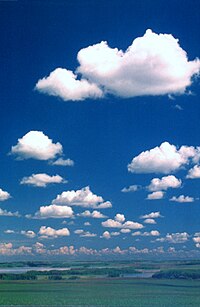
Back Wolk Afrikaans Wolke ALS ደመና Amharic Boira AN Wolcen ANG Oduku inyọn̄ ANN बादल ANP سحاب Arabic ܥܢܢܐ ARC سحاب ARZ

A cloud is water vapour in the atmosphere (sky) that has condensed into very small water droplets or ice crystals that appear in visible shapes or formations above the ground.
Water on the Earth evaporates (turns into an invisible gas) and rises up into the sky. Higher up where the air is colder, the water condenses: it changes from a gas to drops of water or crystals of ice. We see these drops of water as clouds. The drops fall back down to earth as rain, and then the water evaporates again. This is called the "water cycle".
The atmosphere always has some water vapour. Clouds form when the atmosphere can no longer hold all the invisible air vapor.[1] Any more water vapor condenses into very small water drops.[1]
Warm air holds more water vapor than cool air.[1] So if warm air with lots of water inside cools, it can form a cloud. These are ways air can cool enough to form clouds:
- when air close to the ground is heated by the sun and rises to where the air is colder.
- along weather fronts warmer air is cooled as it runs into colder air;
- when air goes up the side of a mountain it cools as it goes higher;
- when warm air goes over something colder (such as cool water in a lake) or ground that is cooled at night it cools.
Clouds are heavy. The water in a cloud can have a mass of several million tons. Every cubic metre (m3) of the cloud has only about 5 grams of water in it. Cloud droplets are also about 1000 times heavier than evaporated water, so they are much heavier than air. They do not fall, but stay in the air, because there is warm air all round the heavier water droplets. When water changes from gas to droplets, this makes heat. Because the droplets are very small, they "stick" to the warm air.
Sometimes, clouds appear to be brilliant colors at sunrise or sunset. This is due to dust particles in the air.